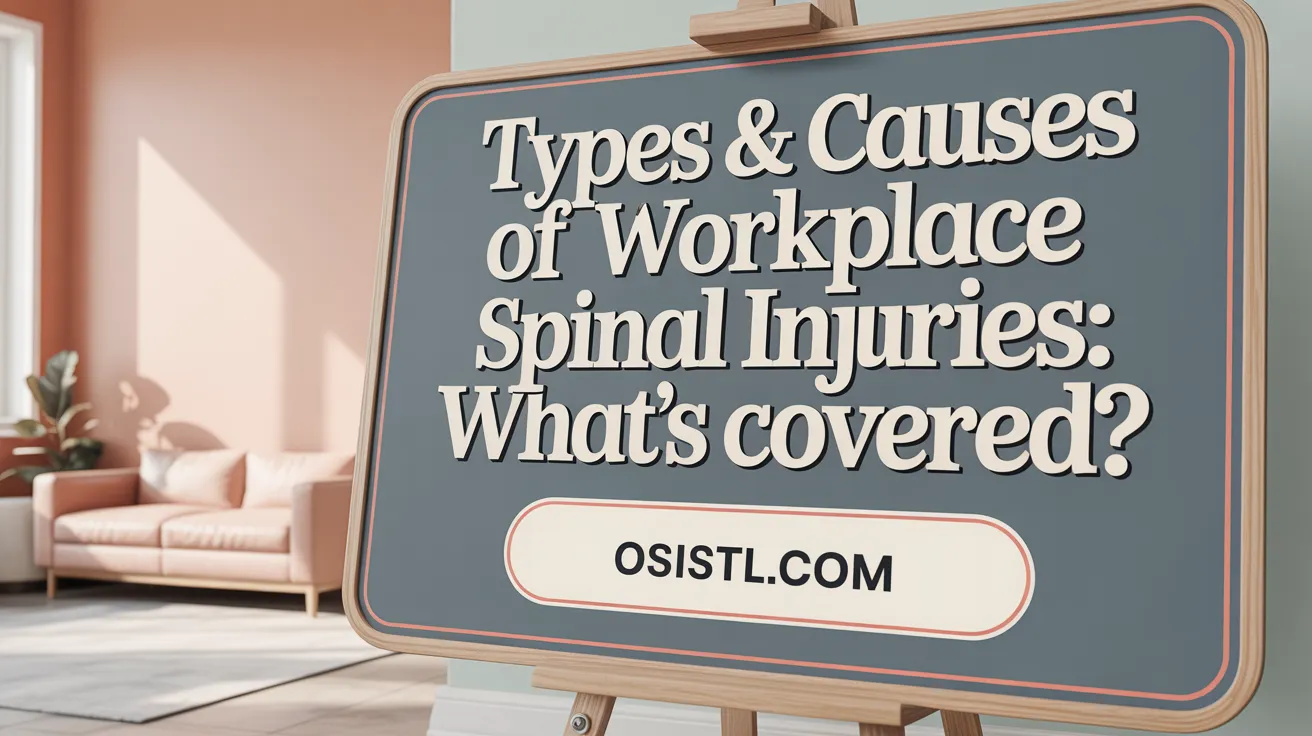Understanding Workers’ Compensation and Spine Injuries
Spinal injuries related to workplace accidents or conditions constitute a significant portion of workers’ compensation claims annually. These injuries can range from minor strains and sprains to severe spinal cord trauma resulting in paralysis and permanent disability. Navigating the complexities of workers’ compensation law, the claim filing process, medical treatments, and legal rights is essential for injured workers seeking fair compensation and care. This guide provides an in-depth overview of workers’ compensation as it pertains to spine injuries, highlighting key aspects including covered injury types, claim procedures, medical coverage, compensation settlements, benefit durations, and available resources for support and legal assistance.
Workers' Compensation Laws and Benefits Specific to Spine Injuries

What are workers' compensation laws and benefits related to spine injuries?
Workers' compensation laws serve as a safety net for employees who suffer injuries on the job, including serious spine injuries such as herniated discs, spinal stenosis, fractures, and other trauma to the vertebrae or spinal cord. These laws require employers to carry insurance that covers medical treatment, wage replacement, and rehabilitation services for injured workers, regardless of fault. For spine injuries, benefits typically include coverage for surgeries, physical therapy, medications, assistive devices, and sometimes home modifications necessary for mobility (Workers' compensation for spine injuries).
The process to obtain benefits involves promptly reporting the injury to the employer, seeking medical attention, and filing a claim with the employer’s insurance carrier. This claim is reviewed and processed, often leading to periodic or lump-sum settlements depending on the severity and expected recovery timeframe (Filing a workers' compensation claim). Benefits are designed not only to facilitate recovery but also to provide financial stability during periods of disability (Workers' compensation benefits). Federal and state agencies administer various programs to ensure these protections extend to public sector workers, with the main objective being to support injured employees' path to recovery and maintain their financial security.
Overall, workers' compensation laws offer comprehensive support, covering medical expenses and wage loss, helping those with spine injuries manage both health and financial challenges after a work-related incident (Workers' Compensation for Spinal Injuries).
Types of Spine Injuries Covered and Causes of Workplace Spinal Injuries

What types of spine injuries are covered by workers' compensation?
Workers' compensation generally covers a broad spectrum of spine injuries that result from work-related activities. These injuries include common back strains and sprains, herniated or bulging discs, and fractured vertebrae caused by various occupational hazards. Serious injuries involving nerve damage, paralysis, or long-term disability are also usually covered, especially when they require hospitalization, surgeries, or long-term rehabilitation. Benefits for such injuries typically encompass medical expenses, lost wages, and disability compensation. For more details, see Workers' compensation for back injuries and Workers' compensation for spine injuries.
To qualify for coverage, the injury must be confirmed as work-related through medical documentation and other evidence. Employees are responsible for reporting their injuries promptly and filing their claims within designated timeframes. By providing appropriate proof and following proper procedures, injured workers can access the benefits they need for their recovery and ongoing disability management. More information on reporting and claims can be found at Filing a workers' compensation claim and Workers' compensation claims process.
Causes of workplace spinal injuries
Spinal injuries at work can occur due to various hazards and unsafe work practices. Common causes include heavy lifting, falls from heights, slips, and being struck by objects or machinery. Repetitive motions, poor ergonomics, and high-force physical activities also contribute significantly to the risk of spinal damage. Workplace sources are explained in Causes of workplace back injuries and Work-related spine injuries.
Work environments such as construction sites, warehouses, manufacturing plants, and healthcare facilities tend to have higher incidences of spinal injuries. Occupational hazards like heavy equipment use, unstable surfaces, and insufficient safety protocols increase the likelihood of traumatic spinal injuries. Understanding these causes helps employers implement safety measures to reduce the risk and ensure workers' well-being. See additional insights in Spinal injuries overview and workplace causes.
Symptoms and severity spectrum of spinal injuries
Spinal injuries can manifest through a wide range of symptoms, from mild discomfort to severe pain and paralysis. Initial signs may include sharp pain in the back or neck, numbness, tingling, weakness, and loss of mobility. Detailed symptoms and severity levels are described in Symptoms of spinal cord injuries and Symptoms of spinal injuries and severity.
More severe injuries might lead to loss of sensation, impaired bodily functions, or complete paralysis depending on the injury level and severity. Some workers experience balance issues, dizziness, or difficulties with bladder and bowel control. The spectrum of injuries varies from minor strains, which tend to heal within weeks, to devastating traumatic injuries requiring extensive medical intervention. For treatment and prognosis, review Spinal cord injury treatment and prognosis.
Workplace environments with higher risk for spinal injuries
Certain industries and work settings pose higher risks for spinal injuries. Construction, manufacturing, warehousing, and healthcare are among the most hazardous due to the physical nature of the work. Relevant data on high-risk workplaces can be found in Workplace back injury statistics and causes and Workplace injuries causing spinal trauma.
Workers engaged in tasks involving heavy lifting, repetitive motions, working in awkward postures, or operating heavy machinery face increased risks. Falls from elevated surfaces or slips, as well as being struck by falling objects, are prevalent causes in these environments. Implementing strict safety protocols, providing proper training, and using ergonomic equipment can mitigate these risks and protect workers from severe spinal injuries. For safety and prevention strategies, see Causes and prevention of spinal injuries at work and Occupational injury safety guidelines.
Filing a Workers’ Compensation Claim for Spine Injuries: Procedures and Proof
What are the procedures and steps for filing a workers' compensation claim for back or spine injuries?
In states like Missouri, an injured worker should immediately report the injury to their employer, ideally in writing, and provide all relevant details about the incident. The worker must then complete and submit a Claim for Compensation form, which can be filed online through the ECOMP portal or mailed to the Missouri Division of Workers' Compensation. This must be done within specific time limits—generally within two years of the injury or last benefit payment, or within three years if the employer did not file a required Report of Injury. For more details, see Filing a workers' compensation claim in Missouri and Steps to file workers' compensation in Chicago.
Once the claim is submitted, the employer's insurance carrier investigates the case to determine if the injury is eligible for benefits. If approved, the worker can receive medical treatment, wage replacement, and possibly disability benefits. If the claim is denied, the worker can appeal the decision or seek legal advice to pursue further action. Throughout this process, it is crucial to maintain detailed records of medical treatment, reports, and communications. See Workers' compensation claims process and legal help and Legal options for workers' compensation.
How can a worker prove that their spinal injury is work-related to qualify for workers' compensation benefits?
Proving a work-related spinal injury relies on establishing a clear link between the injury and employment activities. Promptly reporting the injury helps preserve documentation and credibility. Medical records are vital—these should specify the injury, diagnosis, treatment plan, and any work restrictions imposed by healthcare providers. For guidance, see Medical documentation for spine injuries and workers' compensation and Medical benefits for spine injuries under workers' compensation.
Additional evidence such as eyewitness testimony, incident reports, safety records, and photos of the accident scene can support the claim. Expert medical opinions can also demonstrate that the injury occurred during work or was aggravated by work conditions rather than pre-existing issues. Collecting and presenting this evidence effectively can significantly strengthen the case for benefits. More information is available on Proving work-related back injuries and claims and Preserving accident scene evidence and reporting requirements.
In summary, consistent documentation, immediate reporting, and thorough medical proof are essential steps for establishing that a spine injury is work-related and qualifies for workers' compensation. See also Workers' compensation for spinal injuries overview.
Medical Treatment and Coverage for Workplace Spinal Injuries

What medical treatments are typically covered under workers' compensation for workplace spinal injuries?
Workers' compensation generally provides comprehensive medical coverage for spinal injuries incurred at work. This includes diagnostic procedures such as X-rays, MRI scans, and CT scans to accurately assess the extent of vertebral or spinal cord damage. These tests help determine the severity and appropriate treatment plan (Spinal injuries overview).
Conservative treatments are the first line of care and are usually fully covered. These encompass physical therapy aimed at improving mobility, strength, and flexibility, as well as activity modifications and patient education to prevent further injury (Medical Treatment Guidelines for Back Injuries). Medications like NSAIDs or acetaminophen are provided to manage pain and inflammation.
If conservative management does not yield sufficient improvement, surgical options such as spinal fusion, discectomy, or decompression may be authorized. Such surgeries are supported by medical evidence indicating they are necessary to stabilize the spine or alleviate nerve compression (Spinal fusion surgery settlements).
Post-surgical rehabilitation, including physical and occupational therapy, is an essential component of recovery and is typically covered (Spinal cord injury treatment, Workers’ Compensation Back Injury Care). Assistive devices, like mobility aids or orthotic supports, are included to help restore function or compensate for impairments (Rehabilitation after spinal injury).
Adherence to evidence-based treatment guidelines is emphasized, ensuring the care provided is appropriate and effective. Prompt and integrated treatment under workers' compensation strives to optimize outcomes, reduce long-term disability, and facilitate a safe return to work (Workers' compensation benefits).
Settlement Amounts, Benefit Duration, and Factors Influencing Compensation
 The amount awarded for spine injury claims through workers' compensation varies widely depending on several critical factors. Averaging around $94,285 in 2023, settlements are influenced heavily by injury severity, medical costs, and the long-term impact on the worker's ability to earn. More severe injuries such as spinal cord damage or multiple herniated discs often lead to higher compensation, sometimes exceeding $100,000, especially when permanent disability is involved (Workers' comp spine injury settlement amounts, Spinal cord injury classifications).
The amount awarded for spine injury claims through workers' compensation varies widely depending on several critical factors. Averaging around $94,285 in 2023, settlements are influenced heavily by injury severity, medical costs, and the long-term impact on the worker's ability to earn. More severe injuries such as spinal cord damage or multiple herniated discs often lead to higher compensation, sometimes exceeding $100,000, especially when permanent disability is involved (Workers' comp spine injury settlement amounts, Spinal cord injury classifications).
Settlement determinations primarily consider the injury’s severity, the medical expenses incurred—including surgeries, rehabilitation, and assistive devices—and the extent of permanent impairment. Workers with injuries that result in long-term or lifelong disabilities tend to receive larger settlements to cover ongoing care and lost earning capacity (Workers' Compensation Settlement, Spinal Fusion Surgery Settlements).
In terms of benefit duration, most spine injuries receive temporary benefits covering medical expenses and wage replacement within the initial recovery period. Typically, non-catastrophic injuries in states like Georgia provide up to 400 weeks of benefits, including temporary total disability and medical coverage. For severe or catastrophic cases, benefits may extend for a lifetime, incorporating ongoing medical care, permanent partial disability payments, and vocational rehabilitation (Workers' compensation benefits, Workers' compensation overview).
Legal representation can significantly influence the settlement amount and benefits duration. Experienced attorneys can better navigate the complexities of claims, ensure proper documentation, and advocate for higher settlements that account for future needs (Role of a workers' compensation attorney, Legal assistance for workers' compensation claims).
Benefit duration also varies by state laws. Some, like Georgia, specify caps on temporary benefits but extend support for catastrophic injuries. Overall, the process aims to balance fair compensation with the long-term needs of injured workers, emphasizing the importance of legal guidance to optimize outcomes (Workers' compensation claims process, Workers Compensation Lawyer in Missouri).
Legal Rights, Considerations, and Resources for Workers with Spine Injuries

What legal rights and considerations do injured workers with spinal injuries have?
Workers who sustain spinal injuries on the job are protected by a comprehensive framework of legal rights under workers' compensation for spinal injuries. These laws generally guarantee coverage for medical expenses, wage replacement, and benefits for permanent disability if applicable. Injured workers have the right to promptly report their injury to ensure eligibility for benefits, access and review their medical records, and appeal if their claim is denied or benefits are reduced.
In cases where a third party—such as a defective piece of equipment or a negligent property owner—contributes to the injury, workers may also have the option to file a separate personal injury lawsuit for additional damages. Employers are required to uphold safety standards under OSHA regulations, and employees are protected from retaliation if they report unsafe conditions or exercise their legal rights. Moreover, under the Americans with Disabilities Act (ADA), employees with disabilities resulting from spinal injuries are entitled to reasonable accommodations that enable them to perform their essential job functions.
What resources and legal assistance options are available for workers injured in spine-related incidents?
Individuals injured in spine-related workplace incidents can access a variety of resources to support their recovery and legal rights. Most workers are eligible for workers’ compensation benefits for spine injuries, which cover medical treatment, wage loss, and potentially long-term disability if the injury results in significant impairment. If a claim is unfairly denied, legal help can be crucial in appealing the decision and negotiating for appropriate compensation.
Legal assistance may also involve pursuing third-party claims if another party’s negligence caused the injury. For example, a defective machine or unsafe premises may present opportunities for additional lawsuits outside workers’ compensation.
Workers are encouraged to contact their state’s workers’ compensation board, legal aid organizations, and employment protection agencies for guidance. These agencies can offer support services, help file claims, and advocate for the worker’s rights and benefits. Engaging an experienced workers’ compensation attorney can significantly improve the chances of a fair settlement, ensure proper documentation, and provide representation in disputes or hearings. Overall, understanding and utilizing these resources can greatly assist injured workers through their recovery and legal processes.
Navigating Workers’ Compensation for Spine Injuries Successfully
Spine injuries sustained in the workplace pose serious challenges that affect physical health, employment, and financial stability. Workers’ compensation serves as a vital mechanism to provide injured employees with medical care, wage support, and disability benefits. Understanding the types of spine injuries covered, the claims process, medical treatment options, and legal rights empowers workers to pursue their compensation effectively. Timely reporting, thorough documentation, and seeking legal advice can considerably improve outcomes. With appropriate resources and guidance, workers navigating spine injury claims can secure the compensation and care necessary to support their recovery and adapt to new circumstances.
